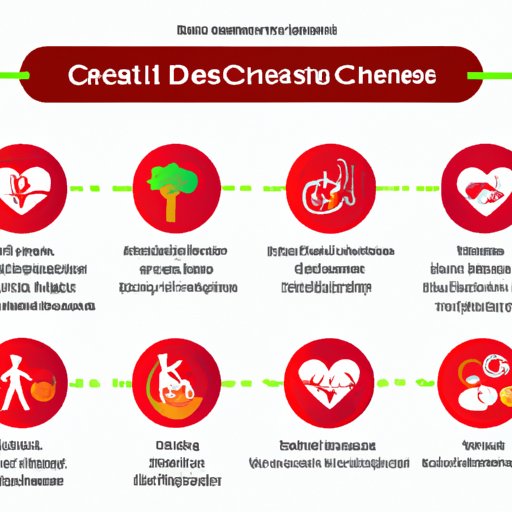
I. Introduction
Cardiovascular disease (CVD) is a leading cause of death worldwide and encompasses a range of conditions affecting the heart and blood vessels. As such, disease prevention programs have been developed to help reduce the risk of this disease. This article aims to explore how disease prevention programs attempt to reduce CVD, considering various categories that include dietary interventions, early detection, innovative preventive measures, and community awareness and education.
II. Understanding the Impact of Lifestyle Choices
Several lifestyle choices can increase the risk of CVD, including smoking, excessive drinking, and lack of physical activity. These choices can negatively affect the heart and blood vessels by leading to high blood pressure and the buildup of cholesterol.
To reduce the risks associated with these lifestyle choices, individuals can adopt healthier habits such as quitting or reducing smoking and alcohol intake. Engaging in regular physical activity such as walking, or engaging in aerobic exercise programs, can significantly reduce the risk of developing CVD. Other strategies include losing weight, controlling cholesterol and blood pressure levels, and avoiding, for instance, processed and high-sodium foods. These habits can aid in preventing or managing CVD risk factors.
III. Importance of Early Detection and Diagnosis
Early detection can be crucial in preventing the development of CVD and reducing its impact. Understanding the warning signs of CVD, such as chest pain and shortness of breath, can help prompt early diagnosis to ensure prompt treatment.
Prevention programs play a key role in raising awareness about the warning signs of CVD and highlighting the importance of early diagnosis. For instance, screening programs can detect CVD in its early stages, allowing interventions such as preventative medications or lifestyle changes to prevent further disease progression.
IV. Dietary Interventions for CVD Prevention
Healthy eating habits can play a major role in reducing the risk of CVD. A healthy diet that includes whole grains, fruits, and vegetables, and lean proteins can help reduce the risk of complications associated with CVD. Adopting healthy eating habits can also help reduce other CVD risk factors such as obesity and high blood pressure.
Disease prevention programs often focus on promoting healthy eating habits through education and counseling, providing meal plans, and partnering with healthcare professionals to ensure patients receive the necessary nutritional support. One example of a heart-healthy dietary intervention is the Mediterranean diet, which involves consuming plant-based foods, fish, and foods high in fiber, while limiting saturated fats and processed foods.
V. Innovative Preventive Measures
Innovative preventive measures such as telemedicine, remote monitoring, and wearables are increasingly being used to manage CVD risk factors remotely. Telemedicine allows patients to consult with healthcare providers virtually to receive medical advice and support remotely, while remote monitoring technology assists healthcare professionals in monitoring patients’ vital signs and providing early intervention when necessary.
Wearables, such as smartwatches, can also help monitor vital signs and collect data about physical activity and heart health. By providing patients with information about their heart health, these technologies can promote self-management of CVD risk factors and improve outcomes.
VI. Community Awareness and Education
Community education and awareness are essential components of CVD prevention programs. Such programs aim to educate the public on the importance of adopting healthier lifestyles and reducing CVD risk factors. These programs may take the form of public lectures, workshops, or media campaigns aimed at promoting healthy habits and sharing vital information about CVD.
Disease prevention programs also work closely with community organizations such as local schools, religious organizations, and community centers to ensure that information on CVD prevention is accessible to all individuals in the community.
VII. Evaluating the Effectiveness of Prevention Programs
As with any healthcare program, measuring the effectiveness of CVD prevention program is essential. Effective prevention programs must take various factors into account, including the demographics of the targeted population, disease risk factors, and the availability of resources.
Current CVD prevention programs have registered success stories in reducing the prevalence of CVD cases and improving outcomes for patients. Some of the most successful programs are those that work closely with healthcare professionals to ensure that patients receive the necessary support and education. Improving access to necessary resources, such as nutritional support, screening programs, and medication, is also crucial in ensuring effective CVD prevention.
VIII. Conclusion
This article has highlighted key strategies for reducing CVD risk factors through disease prevention programs. By adopting healthier lifestyles, monitoring warning signs, and accessing the necessary resources and support, individuals can reduce their risk of developing CVD or manage existing CVD risk factors better. Increase in community awareness and education can support individuals in taking charge of their health, raising awareness about the importance of disease prevention and early detection.
In conclusion, we encourage the adoption of healthy habits, regular check-ups, and engagement with healthcare providers and disease prevention programs to promote a healthier, happier, and heart-disease-free future.




